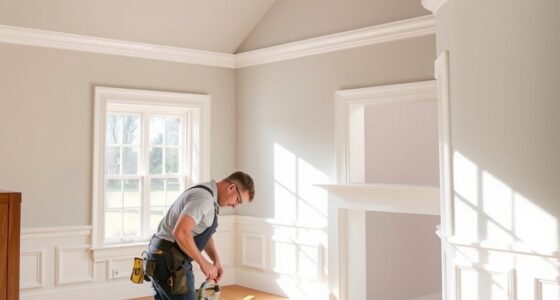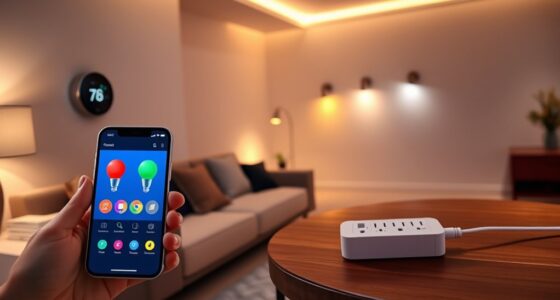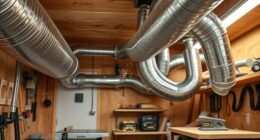To design a portable micro-garden in your apartment, choose lightweight, versatile containers that are easy to move and set up near natural light or grow lights. Incorporate efficient watering systems like self-watering pots or drip irrigation, and arrange your plants on wall shelves or stands to maximize space. Keep everything accessible for maintenance and consider flexible layouts that allow you to adjust as needed. If you continue exploring, you’ll find more tips to make your garden thrive in limited space.
Key Takeaways
- Select lightweight, modular containers and add casters for easy mobility within your apartment.
- Incorporate adjustable grow lights and place near windows for optimal natural or supplemental lighting.
- Utilize self-watering or drip irrigation systems to maintain consistent moisture with minimal effort.
- Design multi-height and wall-mounted shelving to maximize space and enhance visual appeal.
- Plan a flexible layout that allows repositioning of plants based on sunlight, aesthetics, or maintenance needs.

Living in an apartment doesn’t mean you have to miss out on fresh herbs, vegetables, or vibrant greenery. With a portable micro-garden, you can bring nature right into your living space, no matter how limited your square footage. The key is designing a setup that’s both efficient and adaptable. Start by considering your indoor lighting. Natural sunlight is ideal, so place your garden near windows that face south or west to maximize exposure. If sunlight is limited, invest in grow lights that mimic natural daylight; these are essential for healthy plant growth and can be easily set up on adjustable stands or mounted fixtures. Proper lighting ensures your herbs and vegetables thrive, even on cloudy days or during winter months.
A portable micro-garden brings fresh herbs and greenery into your apartment, even with limited space and lighting.
Next, focus on your watering systems. Consistent hydration is vital, but overwatering can be just as harmful as underwatering. To keep things simple, opt for self-watering containers or drip irrigation systems. These setups help maintain the right moisture levels without constant fussing. Self-watering pots have reservoirs that supply water gradually, reducing the risk of overwatering and freeing you from daily watering routines. If you prefer a more hands-on approach, a small watering can with a fine spout allows precise control, especially useful for delicate herbs like basil or cilantro. Whichever method you choose, establishing a regular schedule and monitoring moisture levels will keep your plants healthy and productive.
Container choice is another essential element. Use lightweight, durable materials like plastic or resin that are easy to move around and won’t add unnecessary weight to your space. Modular containers or stackable planters also work well in small areas, allowing you to customize your micro-garden’s layout as your collection grows. Incorporate a mix of sizes and shapes to optimize space and create visual interest. Elevate your containers on stands or wall-mounted shelves to save surface space and improve airflow, which is beneficial for plant health. Additionally, understanding the importance of color temperature adjustments can help optimize the lighting conditions for your plants’ growth.
Lastly, remember that portability is your advantage. Design your micro-garden so it can be moved easily if needed—whether to catch more sunlight, change the room’s aesthetic, or store away during cleaning. Use lightweight containers, attach casters if possible, and keep your watering and lighting systems accessible. This flexibility makes maintaining your indoor garden straightforward and enjoyable. With thoughtful planning, your portable micro-garden can flourish, transforming your apartment into a lush, green retreat.
Frequently Asked Questions
How Do I Ensure Proper Drainage in a Portable Micro-Garden?
To guarantee proper drainage in your portable micro-garden, start by using drainage materials like gravel or small stones at the bottom of your container. This prevents water from pooling and root rot. Also, establish a consistent watering schedule, allowing the soil to dry slightly between waterings. This helps maintain healthy roots and avoids overwatering. Regularly check drainage holes to make sure they’re clear and functioning properly.
What Are the Best Plants for Low-Light Apartment Environments?
Imagine you’ve got a small apartment with limited natural light. You should choose plants like pothos, known for thriving in low-light conditions. These indoor plants require minimal indoor plant lighting and low light plant care, making them perfect for your space. Pothos are resilient, grow quickly, and add greenery without demanding much sunlight, ensuring your micro-garden stays vibrant and healthy even in dim corners.
How Often Should I Water My Micro-Garden?
You should water your micro-garden when the top inch of soil feels dry to the touch, typically every 2-3 days. Stick to a consistent watering schedule to maintain proper plant hydration, but avoid overwatering, which can cause root rot. Check your plants regularly, especially during warmer weeks, to guarantee they get enough moisture without becoming waterlogged. Adjust your watering routine based on your plants’ specific needs and environmental conditions.
Can I Integrate Smart Technology Into My Portable Micro-Garden?
Think of your micro-garden as a symphony, with smart tech conducting perfect harmony. Yes, you can integrate automated watering and app-controlled sensors to keep your plants thriving effortlessly. These sensors monitor moisture levels and trigger watering when needed, so you won’t have to guess or overwater. With a simple app, you can manage your garden from anywhere, transforming your space into a lush, high-tech oasis.
What Are Common Pests or Diseases to Watch For?
You should watch for pests like aphids, spider mites, and whiteflies, which can quickly damage your micro-garden. Regular pest prevention measures, such as removing affected leaves and using natural repellents, help keep pests at bay. Also, be alert for signs of diseases like powdery mildew or root rot. Identifying these issues early allows you to take swift action, protecting your plants and ensuring healthy growth.
Conclusion
By creating your own portable micro-garden, you bring fresh greenery into your apartment and boost your well-being. Did you know that having plants indoors can increase humidity by up to 5%, reducing respiratory issues? With this simple setup, you’ll enjoy the benefits of fresh herbs and a touch of nature anytime. So, get creative and start your micro-garden today — it’s an easy, rewarding way to brighten your space and your mood.









